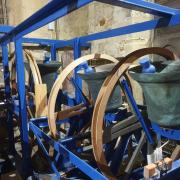Exploring lost worlds and discovering huge carnivorous plants are all part of Stewart McPherson's exciting life, as Jeremy Miles reveals
Dorset’s Real Indiana Jones
Exploring lost worlds and discovering huge carnivorous plants are all part of Stewart McPherson’s exciting life, as Jeremy Miles reveals
Action is something 27-year-old explorer and ecologist Stewart McPherson knows all about. An expert in carnivorous plants, he has travelled to some of the world’s remotest regions in search of hitherto unknown species.
Sitting in the same Hamworthy home overlooking Poole Harbour where, as a child, he used to give his astonished parents detailed lectures on the mechanics of the Venus fly trap, it is easy to see why he was inspired to become an eco-campaigning adventurer.
He talks of the kind of expeditions that to most of us are the stuff of an Indiana Jones movie. Take the time, for instance, when he was guided up a distant mountain in the Philippines by a trio of machete-wielding murderers. “It was on land used by a penal colony,” he explains. “We had to get special permission. The prison authorities eventually agreed, but insisted we took these guys with us. It was an amazing trek and when we finally got to the top – 2,000 metres up – we discovered a plant that hadn’t been seen since 1899.”
I ask how he got on with the murderers. “Oh they were great fellows, absolutely lovely chaps, and were an enormous help clearing our path with their machetes. I think they might have had some awkward questions to answer if we hadn’t come back,” he laughs. I am talking to Stewart during a trip home to visit his parents, Malcolm and Ann, and younger sister Sophie. He only graduated from university four years ago but he is already a seasoned explorer and author of eight specialist books published by his own company, Redfern Natural History Productions, which he runs with dad Malcolm.
Across the waters of Poole Harbour lies the Arne Nature Reserve, while to the west you can see Holton Heath, an official site of special scientific interest. For Stewart, the clincher lies just a couple of hundred metres to the east, where coils of barbed wire and an old military landing craft mark the training ground for the Royal Marine Commandos. “It was pretty exciting growing up here,” says Stewart. “There was always some action going on.”
Stewart talks of a landscape studded with banks of crystals, carpeted with brilliant red gemstones, electric-blue plants and massive waterfalls
Talking to Stewart it is clear that as well as the tens of thousands of geographic miles he has covered, he has also made a long and fascinating personal journey since the days when he used to run the stick-insect club at Castle Court School in Corfe Mullen. Malcolm tells me that he never doubted his son would end up doing something extraordinary.
As a child Stewart was fascinated by the wildlife at Poole Aquarium. One day they contracted a virus and everything had to be evacuated, so they asked the 10-year-old if he could help. “We cleared out his bedroom and put them all in there for a while,” recalls Malcolm. “There were walls and walls of creatures including snakes, millipedes and snails. The noise was amazing. It was like a zoo. His friends were too frightened to sleep over but Stewart loved it!”
Stewart made international headlines last summer when it was revealed that he had discovered a huge but previously unknown variety of pitcher plant growing on the slopes of a distant mountain in the highlands of the Central Philippines. The press had a field day when they learnt that it was big enough to trap small rodents and dissolve them with its flesh-eating enzymes.
He laughed at the attention-grabbing headlines about giant flesh-eating plants that could kill a rat. “Occasionally rodents fall into the pitcher, but the plants haven’t evolved to do this, they have evolved to trap and kill insects.” Stewart went on to name the new plant Nepenthes attenboroughii as “an expression of gratitude” to the man he regards as one of his greatest influences, Sir David Attenborough.Sir David responded by telling the world’s media that he was delighted with the honour and considers the plants to be both “elegant and charming”.
Stewart is currently studying Mount Roraima, a huge plateau deep in the Guiana Highlands of Venezuela. Skirted on all sides by towering 600-metre-high cliffs, this is just one of a hundred plateaux to be found in this densely impenetrable region. They have remained isolated for 70 million years, each developing its own unique ecosystem. Roraima is particularly spectacular, a place of dark legends and superstitions among the tribespeople who inhabit the ancient jungles that stretch for a thousand miles from its base. They regard it as the home of the gods, the place that takes the souls of disgraced warriors. It remained untouched by man until the 19th century, when an ornithologist stumbled upon an overgrown ledge leading from top to bottom. As attempts were made to make the climb, Victorian scientists began to seriously speculate that Roraima could be home to dinosaurs or even undiscovered human civilisations.
Finally, in 1884, Everard Imthurn, an intrepid botanist, made the first ascent and described the sights that greeted him as “some strange country of nightmares”. He spoke of his findings in a celebrated lecture at the Royal Geographic Society. Among those in the audience was Sir Arthur Conan Doyle, who stepped out into the streets of London that night with the inspiration for his book The Lost World.
Though Roraima does not actually harbour dinosaurs or indeed lost civilisations, it offers what is perhaps the greatest concentration of unique plant and animal life. And the arrival of man has done it no favours. Describing it as being like an “island above the clouds”, because it is physically and ecologically so isolated – 70% of its life-forms are found nowhere else on Earth – Stewart says he fears for its future. Until recently he was among just a handful of experts who had made the arduous journey to this mysterious land. He talks of its dramatic valleys, labyrinths of towering, twisted stone, a landscape studded with banks of crystals and carpeted with brilliant red gemstones, electric-blue plants and massive waterfalls. However, increasing accessibility is gradually bringing in wealthy tourists, and with them the introduction of foreign plants and animals. There are also gangs of illegal gold miners and the temptation for visitors to fill their pockets with handfuls of semi-precious stones. This unique natural wonder is being seriously degraded.
Get InvolvedThe Lost World Project is a fundraising competition organised by the environmental charity Ibex Earth, which aims to provide 10 young adults with the adventure of a lifetime. The winners will join an internationally acclaimed crew of professional documentary-makers and travel to Mount Roraima, Venezuela, in August 2010 to help shoot footage for a 50-minute documentary. During the 14-day expedition the team will explore the ‘Lost World’ plateau and film the unique wildlife and scenery that has remained unchanged for millions of years. The overall winner of The Lost World Project will then remain with the crew for an additional three weeks to complete the documentary. The Lost World Project will then be premiered in London in December 2010, and across the UK from January 2011. For details of how to enter ‘The Lost World Project’ competition, log on to www.ibexearth.com and follow the links to the Lost World Project. For more details about Stewart’s expeditions and publications: www.redfernnaturalhistory.com.
“Last time I was there was a year ago and I counted 25 species of introduced plants that have arrived on the shoes of visitors,” he says. “There are animals too that have followed trails of food left by humans.” Stewart is appalled by the implications. “The introduction of new species is wreaking havoc and will wipe out the ecosystem.”Now he has joined the environmental charity Ibex Earth in a project that is looking for ten young adults to join an internationally acclaimed team of documentary-makers on an expedition to discover and film the wildlife, landscapes and growing threats faced by this extraordinary place. Sitting alongside his father, Malcolm, who helps run the Redfern Natural History Productions publishing business, Stewart told me: “We want to raise awareness of the fragility of this area and the conservation concerns. We’re incredibly lucky with the Ibex Earth Project because we’ve got the lead cameramen from BBC’s Planet Earth on board as well as a top BBC producer.”
The resulting 50-minute documentary about the unique wildlife of Roraima will, he hopes, raise the profile and reinforce the efforts that need to be made to protect it. “I desperately want to tell the story of this amazing place and do whatever I can to help. I know we could face criticism because by simply showing the film we will be revealing Roraima to more people. On the other hand, if no one knows what’s happening nothing will ever be done to stop it. I think it’s really important that the damage and destruction is documented and shown.”Let’s hope that Stewart’s desire to protect the fragile eco-system of Roraima succeeds.


























